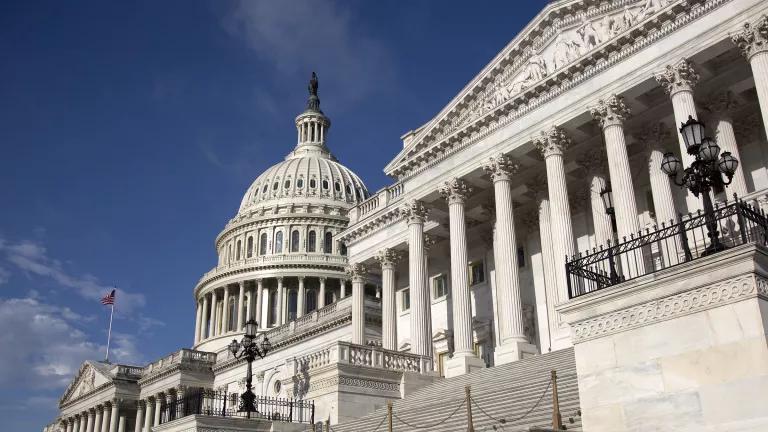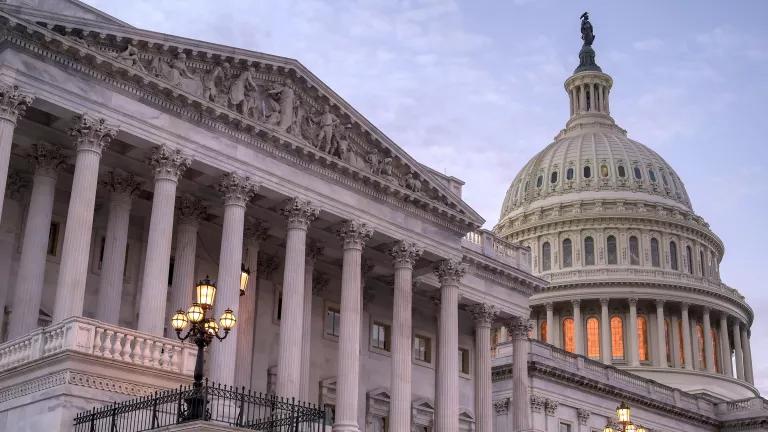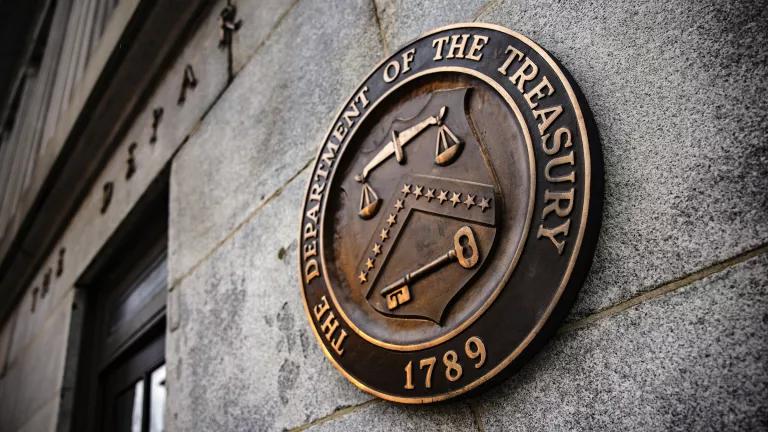Supreme Court Deals EPA a Setback, Not a Death Blow, in Fight Against Climate Change
Plus, the decision announces a new doctrine designed to hamper the government from instituting basic protections, from pollution limits to food and drug safety standards to workplace safety requirements.

Coal-fired Mountaineer Power Plant outside New Haven, West Virginia
Plus, the decision announces a new doctrine designed to hamper the government from instituting basic protections, from pollution limits to food and drug safety standards to workplace safety requirements.
The Supreme Court yesterday set back the U.S. Environmental Protection Agency’s authority to limit carbon pollution from power plants in West Virginia v. EPA. While the decision leaves EPA a path forward on power plants, it also alarmingly expanded a legal theory called the “major questions doctrine,” which the Court has used aggressively in recent decisions to block executive branch action.
This decision comes when we can least afford impediments to climate action. The climate crisis is no longer a hypothetical: Millions in the United States and around the world are already suffering from heat waves, wildfires, drought, and extreme weather driven by climate change—and it’s getting worse, fast.
As we explain below, the Court’s decision creates new obstacles to cleaning up the power sector’s carbon pollution, but it does allow a path forward—and NRDC will push the EPA to move quickly and aggressively. As NRDC President Manish Bapna said in response to the decision: “This leaves the EPA in the climate fight, but makes it harder to win it.”
What did the Court say?
In the 6-3 decision authored by Chief Justice John Roberts, the Supreme Court examined and rejected the 2015 Clean Power Plan through the lens of the “major questions” doctrine—that is, a judicially created anti-regulatory requirement that an executive branch agency cannot tackle significant new problems unless a statute provides “clear congressional authorization.”
The principle that agencies may only do what legislation allows is well-established, but what’s new is the clairvoyance and picayune specificity the Court’s conservative majority now insists Congress must have shown.
For decades, Section 111 of the Clean Air Act has instructed the EPA to determine “the best system of emission reduction” for a wide variety of industries, including power plants, which are among the nation’s the largest polluters. The majority opinion did not dispute that this statutory language allows the EPA to set technology-based standards that require individual plants to “operate more cleanly.” But it held that the language does not clearly authorize the agency to adopt a new approach to setting a standard based on deliberately shifting power generation from coal plants to cleaner generators like wind and solar.
That’s the sensible approach the EPA took in the 2015 Clean Power Plan, in part because it was cheaper and more flexible for the power industry than technology-based standards. Ironically, even though the Court blocked implementation of the Clean Power Plan in 2016, the industry met the plan’s 2030 emission reduction goals in 2019—more than a decade early. And the power industry joined the EPA and environmental organizations in this case to defend the agency’s authority.
The Court did not specifically address the Trump administration’s do-nothing replacement, called the Affordable Clean Energy rule, except to note that it would result in “only small reductions” in power plants’ carbon emissions.
As we explore further below, now the EPA will have to set a new rule based on the Court’s narrower construction of “best system of emission reduction.”

The coal- and gas-fired Capitol Power Plant looms over rush-hour traffic in Washington, DC.
While the decision erects new and unwelcome hurdles, it does not reverse the Court’s two major precedents—Massachusetts v. EPA and American Electric Power v. Connecticut—which established that the Clean Air Act authorizes the EPA to curb climate-changing pollutants from power plants and vehicles.
A concurring opinion by Justices Neil Gorsuch and Samuel Alito advocates even more extreme limits on congressional power to delegate decisions to the executive branch. Although signed by only two justices, the concurrence signals where some of them want to take things next.
Justice Elena Kagan penned a strong dissent, joined by Justices Stephen Breyer and Sonia Sotomayor, defending the legality of the Clean Power Plan, decrying the obstacles the majority has placed in the way of climate action and calling out the broader dangers of expanding the major questions doctrine. “A key reason Congress makes broad delegations like Section 111 is so an agency can respond, appropriately and commensurately, to new and big problems,” she wrote. “Congress knows what it doesn’t and can’t know when it drafts a statute; and Congress therefore gives an expert agency the power to address issues—even significant ones—as and when they arise.”
What’s all this about the major questions doctrine?
The “major questions” doctrine is a power grab by the Court’s conservative majority. As Justice Kagan said in dissent, “Today, one of [the majority’s] broader goals makes itself clear: Prevent agencies from doing important work, even though that is what Congress directed.”
The conservative majority’s move could have far-reaching implications. It is designed to constrain foundational public health and safety, consumer protection, and other laws passed by Congress, preventing government agencies from instituting safeguards like pollution limits, food and drug safety standards, workplace safety requirements, financial regulations, and many other things we have expected government to do to address the problems of a modern society.
On its face, the premise may seem sensible enough: For issues of “economic and political significance” where an agency is using “sweeping and consequential authority,” the agency must point to “clear congressional authorization.” But in practice, it is a major shift of power from Congress (which wrote these laws with the expectation that they could give these tasks to expert agencies) to the courts. The Supreme Court has made itself the sole arbiter of what is a “major” question and whether Congress’s direction to the agency is sufficiently clear.

A young girl watches from the window of her home near the coal-fired General James M. Gavin Power Plant in Cheshire, Ohio.
Moreover, this doctrine operates in only one direction: deregulation. Conservative justices express concern for the “liberty” of corporations that create pollution, and none for the liberty of ordinary people who suffer real harm and great expense from that pollution. Indeed, the Court has used this doctrine aggressively only to block the executive branch’s use of laws adopted over the past half century to address newly emerging threats to our health and welfare.
Even in the good old days when matters like clean air and water were bipartisan concerns—and before Congress was mired in partisan gridlock—Congress was not able to legislate at the fine-grained level the Court’s new majority is retroactively demanding. And it is difficult to imagine that today’s or future Congresses will be able to meet the Court’s requirements for specificity and clarity to address each and every big issue we face.
Although the West Virginia decision directly addresses only the EPA’s authority to regulate carbon pollution from power plants under the Clean Air Act, expect to see this “major questions” rationale used by industry and anti-regulatory political actors to challenge all manner of federal safeguards in the coming years.
What can the EPA do now?
While the EPA is now constrained, it is not foreclosed from limiting carbon pollution from existing power plants.
The decision leaves the door open for the agency to issue carbon pollution standards based on pollution-control measures that can be installed at existing coal and gas plants. Moreover, while the decision precludes the EPA from “simply announcing what the market share of coal, natural gas, wind, and solar must be,” the decision does not prevent it from setting technology-based standards “that may end up causing an incidental loss of coal’s market share.”
Now that the Court has spoken, the EPA needs to act immediately to set standards that will significantly cut the carbon pollution from existing power plants under the authority this decision leaves intact. We need to see a proposal this year and a final rule as soon next year as possible. The climate crisis demands it. The costs to our health and livelihood—and the future—are increasing at breakneck speed. And the toll of human suffering rises with every delay.
The EPA must also continue to move forward with strong Clean Air Act standards for motor vehicle greenhouse gas emissions, limits on methane emissions from oil and gas, and standards to curb health-harming pollution from power plants and industrial sources—regulatory authority untouched by this decision.
There is no way around it—this decision is a setback. The “major questions” doctrine announcement is an alarming development for our government's ability to protect our health, families, and communities from the growing dangers and costs from climate change and other big problems. The EPA now has fewer tools in its regulatory toolbox, but the tools it has left can still be used to make meaningful progress, and that matters.
There’s a lot of work to do. We’ll be pushing the EPA to get it done as soon as possible, and you can join the fight along with us. The climate crisis is upon us, and there’s no time to waste.




